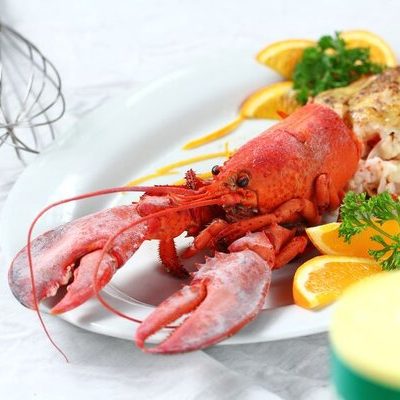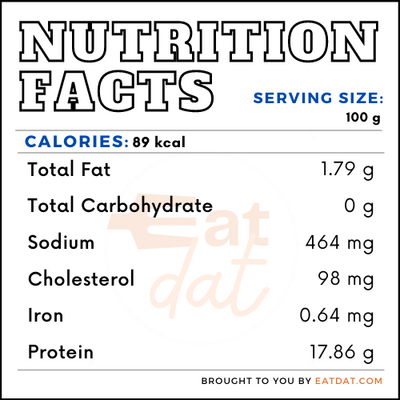
Lobster
What is a Lobster?
Lobster falls under the category of seafood. It belongs to the Nephropidae family of crustaceans with long bodies, claws, and a black-blue color. This is usually prepared by boiling or steaming and served in its shell with butter or lemon juice. When cooked, its color changes to a deep orangish red because of the presence of crustacyanin.
- There are four main species: European, American, rock lobster, and tropical or spiny lobster.
- Canada and the USA account for the highest production in the world, followed by Indonesia, Australia, Brazil, Bahamas, Cuba, Nigeria, Nicaragua, and Mexico.
The top 7 most popular seafood brands in the US are:
- Cooke Aquaculture
- Thai Union North America
- Tri Marine International
- High Liner Foods
- Maruha Nichiro Corp.
- Bumble Bee Seafoods
- Nippon Suisan USA
Origin of lobsters
This seafood has been used as food since prehistoric times. They were even delicacies in ancient Greece and Rome. They were also popular among the British but not among the first American colonists, though the Native Americans used this in abundance. In the beginning, lobsters were so plentiful that the lower classes had their fill of them and they were considered poor people’s food. Since World War II, overconsumption of lobsters have made them more expensive and rare.
Nutrition
A 1oog serving of lobster meat contains:

Lobsters are rich in fats and proteins, as well as in amino acids essential for muscle building, growth, and healthy bodily functions. They also have a good amount of bioactive compounds that can have a positive health impact. Lobsters also contain vitamin A, B vitamins, zinc, phosphorus, selenium, and potassium. However, this food lacks omega-3 fatty acids that are found in most fish.
Commercial Production
Lobster farming requires plenty of clean water. First, the pond is disinfected and cleaned well with cleaning agents and lime to remove harmful gases and viruses. Using natural manures at the bottom will ensure the growth of aquatic organisms and a healthy environment for the lobsters. Its larvae are then placed in the pond and left to hatch. The lobsters are fed seaweed and small fish for about 6 to 7 months, after which they are ready to be harvested. It is important to keep lobsters of the same size together as big ones tend to feed on smaller ones. Farming is a difficult process because the lobsters grow very slowly, require lots of care and sustenance, and are prone to diseases.
Though this seafood is sold frozen, the most popular form is sold fresh. This requires a lot of investment and care in storage and transportation. Lobsters remain alive for only about 24 hours once they are taken out of water. It is believed by many scientists and animal rights activists that the most common method of cooking lobsters – boiling them alive – is a cruel practice. Switzerland became the first country in the world to ban cooking lobsters alive in 2018.
Lobster recipes
This seafood is considered a delicacy in many cultures. There are many ways to prepare this. Here are a few recipes:
- Lobster Tail with Garlic Lemon Butter
- Grilled Lobsters with Garlic-Parsley Butter
- Tandoori
- Boiled Lobster
- Lobster Masala
- Deviled Lobsters
- Thermidor
- Singapore Chilli Lobsters
- Laksa
- Malaysian Spiced Lobster Tail with Leeks
- Lobster Roll
- Roasted Lobster’s Tail with Mirin Dressing
- Cantonese Ginger Scallion Lobster
FDA regulations
Lobster harvesting for recreational purposes is limited to 6 per person per day by the Fish and Wildlife Conservation Commission. The lobster must be at least 3 inches long to be taken out of the water. Harvesting is prohibited in certain parts of the country. Harvesting for commercial purposes is limited to 250 per day per vessel, irrespective of whether bully net gear or diving methods are used.
References
- Graciela Pereira & Helga Josupeit, The World Lobster Market, Globefish Research Programme, Food and Agriculture Organization of the United Nations
http://www.fao.org/3/a-i6816e.pdf - Lynne Olver, FAQs: fish & shellfish, Food Timeline http://www.foodtimeline.org/foodlobster.html
- Hosomi, Ryota et al. “Seafood consumption and components for health.” Global journal of health science vol. 4,3 72-86. 28 Apr. 2012, doi:10.5539/gjhs.v4n3p72, https://www.ncbi.nlm.nih.gov/pmc/articles/PMC4776937/
